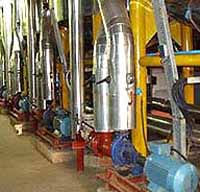
- Pretreatment Section of the Oil Mill Plant
- Pressing Section for Oil Mill Plant
- Solvent Extraction Plant
- Oil Refining Plant
- Filling Section of the Oil Mill Plant
- Oil Modification Plant
- Seed Processing Plant
- Small Oil Production Line
- oil press
- YZS-30 Sesame Oil Pressing Machine
- YZS-68 Soya Oil Press
- YZS-80 Canola Oil Press
- YZS-95 Sunflower Seed Oil Press
- YZS-100 Oil Expeller Press
- YZS-120 Oil Pressing Machinery
- YZS-130 Screw Oil Press
- YZS-160 Oil Seed Press
- YZS-80A Combined Oil Press
- YZS-95A Automatic Oil Press Machine
- YZS-100A Automatic Oil Expeller
- Steel Silo
- Face Mask
- Oil Production Process 5S Groundnut
- Physical Refining Process Of The Edible Oil Refining Machine
- Cottonseed Oil Processing Equipment
- Something About Sunflower Oil Extraction Machine
- Something About Soybean Oil Refining Machine
- Something About Edible Oil Solvent Extraction
- Rice Bran Oil Extraction Equipment
- Soybean Oil Refining Equipment
cooking oil production
Cooking Oil Production
Cooking oil is purified fat of plant origin, which is usually liquid at room temperature, cooking oil production, however,is really not a simple process as you can image.
some of the many different kinds of edible vegetable oils include: olive oil, palm oil, soybean oil, canola oil, pumpkin seed oil, corn oil, sunflower oil, safflower oil, peanut oil, grape seed oil, sesame oil, argan oil and rice bran oil. Many other kinds of vegetable oils are also used for cooking.

Cooking Oil Production - Cleaning and Grinding
The raw material oil seeds are passed over magnets to remove any trace metal before being dehulled, deskinned, or otherwise stripped of all extraneous material. Mechanized grooved rollers or hammer mills crush the material to the proper consistency. The meal is then heated to facilitate the extraction of the oil. While the procedure allows more oil to be pressed out, more impurities are also pressed out with the oil, and these must be removed before the oil can be deemed edible.
Cooking Oil Production - Pressing
Heated meal is then fed continuously into a screw oil press, which increases the pressure progressively as the meal passes through a slotted barrel. Pressure generally increases as the oil is squeezed out from the slots in the barrel, where it can be recovered.
Cooking Oil Production - Extracting Additional Oil with Solvents
Oilseeds like soybeans are usually not pressed at all before solvent extraction process, because they have relatively little oil, but most oil seeds with more oil are pressed and solvent-treated. After the initial oil has been recovered from the screw press, the oil cake remaining in the press is processed by solvent extraction to attain the maximum yield. A volatile hydrocarbon (most commonly hexane) dissolves the oil out of the oil cake, which is then recovered by distilling the light solvent out. In using a special machine, flakes of meal are sent through wedge-shaped cells of a cylindrical vessel. The solvent then passes through the matter to be collected at the bottom. The solvent percolates through the matter which is periodically dumped and replaced.
Cooking Oil Production - Oil Refining
The oil is next refined to remove color, odor, and bitterness. Refining consists of heating the oil to between 107 and 188 degrees Fahrenheit (40 and 85 degrees Celsius) and mixing an alkaline substance such as sodium hydroxide or sodium carbonate with it. Soap forms from the undesired fatty acids and the alkaline additive, and it is usually removed by centrifuge. The oil is further washed to remove traces of soap and then dried.
We are always ready to serve you.


